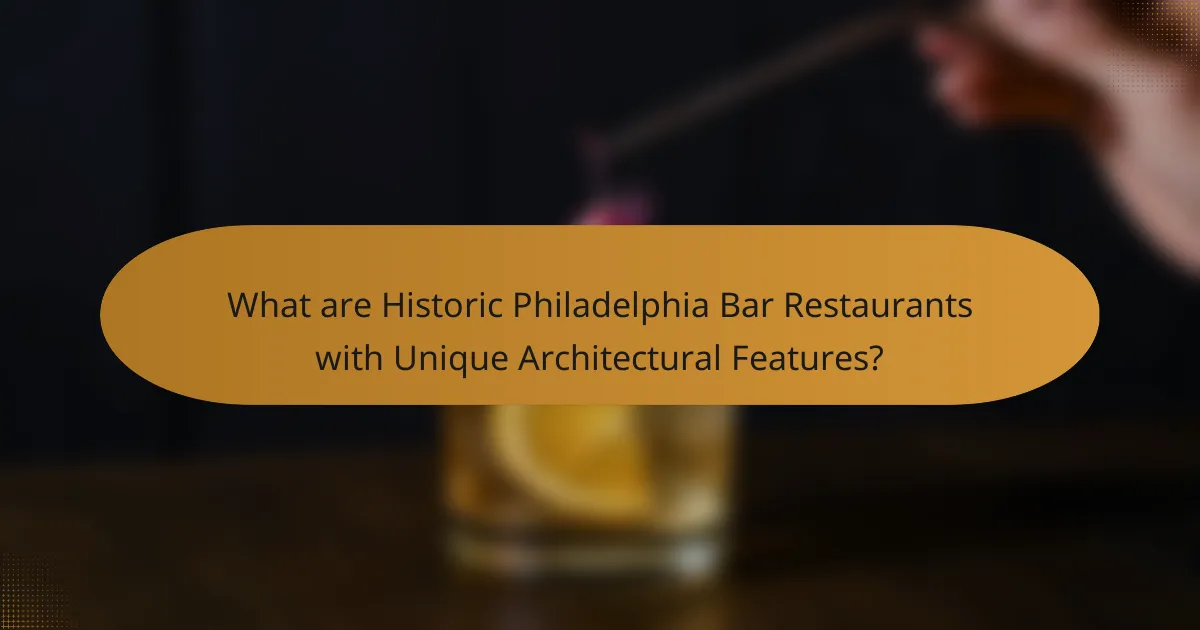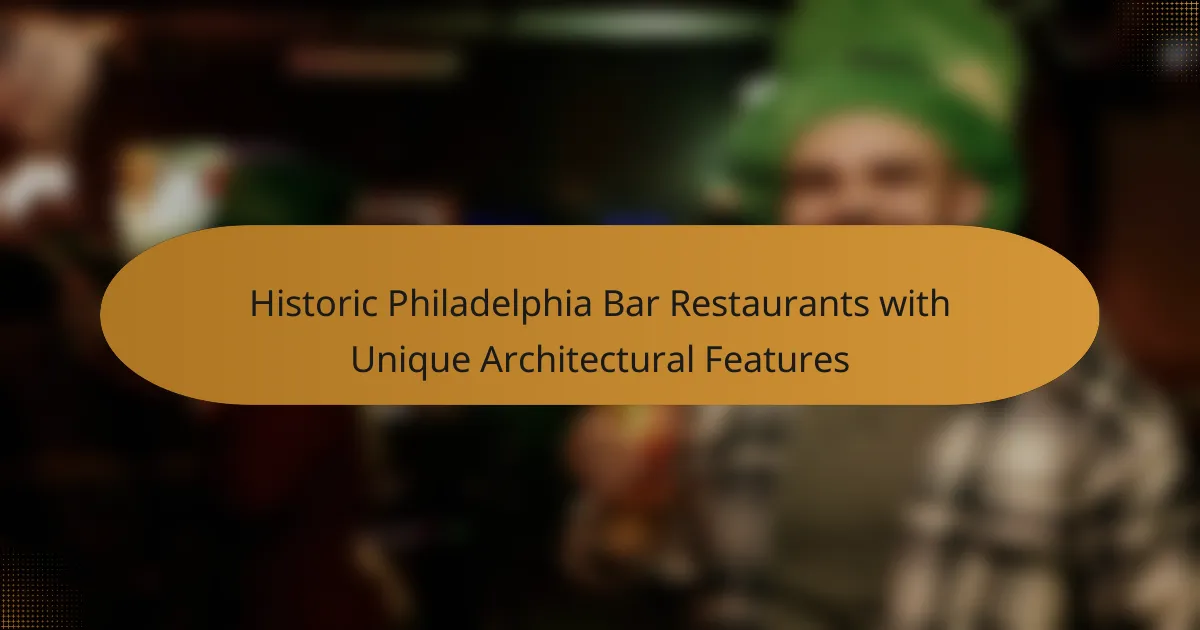
What are Historic Philadelphia Bar Restaurants with Unique Architectural Features?
Historic Philadelphia bar restaurants with unique architectural features include the City Tavern, McGillin’s Olde Ale House, and the Franklin Mortgage & Investment Co. City Tavern, established in 1773, showcases colonial architecture and was frequented by Founding Fathers. McGillin’s Olde Ale House, operating since 1860, features Victorian design elements and original woodwork. Franklin Mortgage & Investment Co. has a Prohibition-era aesthetic, highlighting intricate tile work and vintage decor. These establishments reflect Philadelphia’s rich history and architectural diversity.
How do architectural features define the character of these establishments?
Architectural features significantly define the character of historic Philadelphia bar restaurants. These establishments often showcase unique styles, such as Federal, Victorian, or Colonial architecture. Distinctive elements like brick facades, ornate moldings, and large windows contribute to their ambiance. The design reflects the historical context and cultural heritage of the area. For example, high ceilings and wooden beams create a warm, inviting atmosphere. Additionally, the layout influences social interaction among patrons. Overall, architectural features are integral to the identity and charm of these dining venues.
What types of architectural styles are commonly found in these bar restaurants?
Common architectural styles found in historic Philadelphia bar restaurants include Federal, Georgian, and Victorian. Federal style features symmetrical facades and decorative elements like fanlights. Georgian architecture is characterized by its brick construction and classic proportions. Victorian style often showcases intricate details and ornate woodwork. These styles reflect Philadelphia’s rich history and cultural influences. Many bar restaurants have preserved these architectural features, enhancing their appeal. The combination of these styles creates a unique dining atmosphere.
How do historical influences shape the architecture of these venues?
Historical influences significantly shape the architecture of historic Philadelphia bar restaurants. Architectural styles reflect the city’s diverse history, including Colonial, Federal, and Victorian designs. Colonial architecture features symmetrical facades and brick construction, common in early establishments. Federal style adds decorative elements like fanlights and pilasters, enhancing visual appeal. Victorian influences introduce intricate details and ornate designs, reflecting the era’s prosperity.
Cultural movements also impact architecture. The Arts and Crafts movement emphasizes craftsmanship, seen in some bar interiors. Preservation efforts maintain historical integrity, ensuring original designs are honored. These venues often incorporate local materials, connecting to Philadelphia’s heritage. Overall, historical influences create a unique architectural identity for these establishments.
Why are these bar restaurants significant to Philadelphia’s cultural heritage?
Historic Philadelphia bar restaurants play a crucial role in the city’s cultural heritage. They serve as gathering places that reflect Philadelphia’s rich history and community spirit. Many of these establishments date back to the 18th and 19th centuries. They showcase unique architectural styles, contributing to the city’s aesthetic and historical narrative. Notable examples include the City Tavern, which was frequented by Founding Fathers. These venues often host events that celebrate local traditions and cuisine. They preserve stories of the city’s past, fostering a sense of identity among residents. The significance of these bar restaurants lies in their ability to connect people to Philadelphia’s historical roots.
What role do they play in the historical narrative of Philadelphia?
Historic Philadelphia bar restaurants with unique architectural features serve as cultural landmarks in the city’s historical narrative. They reflect the evolution of Philadelphia’s social and economic landscape. These establishments often housed significant events and gatherings throughout history. For instance, many were frequented by key figures during the American Revolution. Their architectural designs showcase various historical styles, contributing to the city’s architectural heritage. Additionally, they preserve local traditions and culinary practices. This intertwining of food, drink, and history enhances Philadelphia’s identity as a vibrant cultural hub. Overall, they are vital in connecting past and present within the city’s narrative.
How do these establishments contribute to local tourism?
Historic Philadelphia bar restaurants with unique architectural features attract tourists by offering a blend of history and cuisine. These establishments showcase the city’s rich heritage through their design and ambiance. Tourists often seek experiences that reflect local culture. Unique architecture enhances the dining experience, making it memorable. According to a study by the Philadelphia Convention and Visitors Bureau, over 40% of visitors engage with historic sites and restaurants during their stay. This engagement boosts local economies through increased spending on food and drinks. Additionally, these establishments often host events that draw in crowds, further promoting tourism.
What experiences can patrons expect at these unique bar restaurants?
Patrons at unique bar restaurants in historic Philadelphia can expect a blend of distinctive architecture and vibrant atmospheres. These establishments often feature historical elements such as exposed brick, vintage woodwork, and ornate moldings. Guests may enjoy curated menus that highlight local ingredients and craft beverages. Many offer themed decor that reflects the history of the building or neighborhood. Live music and events are common, enhancing the social experience. Additionally, patrons often appreciate outdoor seating options that showcase the city’s charm. The combination of history, ambiance, and culinary offerings creates a memorable dining experience.
What types of cuisine are typically offered in conjunction with the architecture?
Historic Philadelphia bar restaurants typically offer American, Italian, and Irish cuisine. These cuisines reflect the city’s diverse cultural heritage. American cuisine often includes classic dishes like burgers and sandwiches. Italian cuisine features pasta, pizza, and seafood. Irish cuisine offers traditional options such as shepherd’s pie and fish and chips. The architectural features of these establishments often complement the dining experience. For example, many historic buildings provide a rustic ambiance that enhances the enjoyment of these cuisines.
How does the ambiance reflect the architectural features of the venue?
The ambiance of a venue reflects its architectural features through design elements, materials, and spatial arrangements. For example, high ceilings and large windows create an open and airy feel. This openness enhances the overall atmosphere, making it inviting. The use of exposed brick and wooden beams often evokes a sense of history. Such materials contribute to a warm and rustic ambiance. Lighting fixtures can also highlight architectural details, creating focal points within the space. This interplay between light and structure enhances the venue’s character. The layout, including seating arrangements, influences social interaction and comfort, further shaping the ambiance. Overall, the architectural features and ambiance work together to create a cohesive experience for patrons.
How can visitors find and choose the best historic bar restaurants in Philadelphia?
Visitors can find and choose the best historic bar restaurants in Philadelphia by researching online reviews and ratings. Websites like Yelp and TripAdvisor provide user-generated content that highlights customer experiences. Additionally, local food blogs often feature recommendations for historic venues.
Visitors should also consider the architectural significance of these establishments. Many historic bars have unique designs that reflect Philadelphia’s rich history. Dining guides and historical society publications can offer insights into these features.
Lastly, asking locals for their favorites can lead to authentic recommendations. Engaging with residents often uncovers hidden gems that may not be widely advertised.
What resources are available for discovering these unique venues?
Online platforms like Yelp and TripAdvisor provide user-generated reviews and photos of unique venues. Social media sites such as Instagram showcase visually appealing venues through hashtags. Local tourism websites often list historic bar restaurants with architectural significance. City guides and blogs focus on unique dining experiences in Philadelphia. Apps like Foursquare offer location-based recommendations for unique venues. Additionally, architectural preservation organizations may provide insights on historically significant establishments. These resources collectively help discover unique bar restaurants in Philadelphia.
What tips should visitors consider when planning their visit to these establishments?
Visitors should consider making reservations in advance for historic Philadelphia bar restaurants. Many of these establishments have limited seating due to their unique architectural layouts. Arriving early can help secure a good spot, especially during peak hours. Familiarizing oneself with the menu beforehand can enhance the dining experience. Some restaurants may offer specialty dishes that highlight local history. Checking for any special events or live music can add to the visit. Understanding the establishment’s historical significance can enrich the overall experience. Lastly, reviewing visitor feedback online can provide insights into the best dining options.
Historic Philadelphia bar restaurants with unique architectural features are significant cultural landmarks that reflect the city’s rich history and diverse architectural styles, including Colonial, Federal, and Victorian designs. Notable establishments such as City Tavern, McGillin’s Olde Ale House, and Franklin Mortgage & Investment Co. showcase distinctive elements that enhance their ambiance and dining experience. These venues play a vital role in the historical narrative of Philadelphia, connecting patrons to the past while contributing to local tourism through their unique offerings and engaging atmospheres. Visitors can discover these establishments through various online resources and local recommendations, ensuring an authentic experience that highlights the intersection of history and cuisine.



